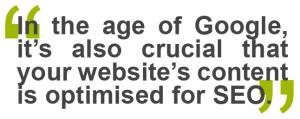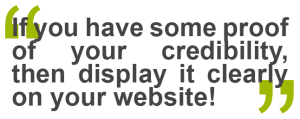6 Ways Your Website is Losing Leads (And How to Fix It)
Your website is where many customers will meet you and your business for the first time. First impressions, particularly for a business, are crucial – in the age of Google, with so many competitors just a click away, you won’t always get a second chance.
Nobody knows your business better than you do, so writing the content for your website seems like an easy task. But there’s more to web content than simply words on a screen, and understanding what to write – and what not to write – will see your website’s visitors staying longer, and clicking on your calls to action more often.
 1. You Need the Right Amount of Content
1. You Need the Right Amount of Content
When it comes to content, it’s crucial to strike a balance between “too little” and “too much”. Your content should seek to answer all of the major questions your audience is likely to ask: Who are you? What do you do? Where are you and how can your audience access your services or product? What can you do for them? A website that has not answered even one of these questions has failed.
However, just as important as knowing what to tell your website’s visitors is knowing what not to tell them. Have you ever found your eyes sliding off a page crammed with too much text? It’s easy to confuse quantity for quality – but while obscure trivia facts about the industry your business is situated in, or your founder’s schooling history may seem very interesting to you, to your website’s visitors they are just words taking up space on a screen.
Readability is not the only element your content needs. In the age of Google, it’s also crucial that your website’s content is optimised for SEO. This does not mean simply stuffing your text full of keywords – today’s search engine algorithms are too sophisticated to be fooled by content that sacrifices quality for keywords. However, it is important to weave SEO best practice into your website’s content, as without it, even the most well-written website won’t rank in a search engine’s results.
The key to maintaining the perfect amount of content on your website is to put yourself in the shoes of your audience, and ask yourself: What are they coming to your website for? What do they want to find? This takes us to…
2. You Need to Know Your Customer’s Needs
Before writing any content for your website, it is vital you know what your customer needs. You already know what you can offer and if you’ve done your research, you know who your demographic is – but do you know what their needs are?
This may seem like a question with an obvious answer. For example, perhaps you are a company providing specialist training to other businesses and their members of staff. When asked, “What does your audience need?” the obvious answer is, of course, “Training.” However, to leave it there is to only skim the surface. Try diving a little deeper: Why does your audience need training? What needs will be met by the training you provide? Maybe your training will help businesses meet legal and insurance requirements, or prevent problems or injuries in the workplace or their premises. Perhaps your training will increase the skill-set of your audience’s employees, driving up their revenue and capabilities. With your audience’s particular needs discovered, you can appeal directly to those needs.
3. You Need to Make Your Website Eye-Catching
Words are powerful, and a talented writer can paint a vibrant picture in your mind’s eye – but that’s no reason to neglect your website’s graphic design. An intuitive and easy-to-navigate layout combined with sleek, attractive graphics will encourage visitors to spend more time on your website reading about you and your business.
If you’re selling a product, then photographs are essential – and it’s worth spending the money to make sure your photos are crisp, clear and professional looking. Even one high-quality, professionally taken photo is worth more than nine or ten grainy, small photos taken from different angles.
It’s not just photographs that need to catch the eye. Your calls to action – whether it’s “Email us now”, “Order here”, or “Contact us” – should be clear, easily seen, and easy to follow. A call to action that is tucked away in a spot on your website where it cannot be quickly and easily spotted will be overlooked by the majority of your visitors, while one that is difficult or time-consuming to follow will see your visitors quitting mid-way in frustration. Keep your visitors’ needs in mind, and make your calls to action straightforward and simple.
 4. You Need to Brag a Little
4. You Need to Brag a Little
This may sound like a strange thing to say. Generally, modesty is seen as a virtue – nobody likes conceit. Confidence, however, is compelling.
You could give your visitors a plain, matter-of-fact description of your business – or you could excite and intrigue them by telling them about your state-of-the-art premises, your innovative products, and your unrivalled services.
A newcomer to your website will be looking to discover who you and what you do – but they will also be looking for reasons to trust you over your competitors. The more reason you can give them to put their faith in you, the better. Your business may have won awards or be accredited by industry organisations. If you have proof of your credibility, then display it clearly on your website!
Here at GMA we have seen clients with multiple awards who have tucked away this piece of information on a page hidden in the second or third sub-menu of their navigation, where only 1% of visitors will see it. Other clients have page after page of glowing testimonials and reviews from happy customers – but rather than showing this off on their website, they leave this feather in their cap sitting, unseen, on a Google or Yelp Reviews page. If you have praise or recognition from an external source, be it a satisfied customer, an awards body, or an industry authority, place it front and centre, where every visitor to your website can see it.
5. You Need a Site That’s Easy to Navigate
It’s pointless to spend time crafting engaging copy for your website’s pages if nobody can find them. Very few visitors will be prepared to dig deep into the belly of your website to find the page they want, so make sure you’ve done the digging for them by creating a navigation menu that will take them to the page they’re looking for quickly and easily.
Remember, not all visitors to your website will be humans. Search engines employ bots known as “crawlers” to systematically collect data from websites for use in organising search results. When visiting your site, these crawlers will be looking to index only the most relevant and interesting pages – but without a properly put-together sitemap, they will be left stranded on your website’s front page. A sitemap, usually linked in the footer of your front page, will give Google and Bing’s crawlers the ability to check your website’s other pages, giving you a much higher chance of landing on the front page of their search results.
6. You Need a Cohesive Marketing Strategy
A compelling marketing campaign is a work of art – and like all works of art, its individual elements should work together. A complete marketing strategy will guide all of your subsequent campaigns and efforts, giving you both a short-term and a long-term plan for visible results.
Where a marketing strategy truly shines is in those moments when it saves you valuable time. With a strategy to refer back to for details on your audience, your competitive advantages, your USP, and your key messages, you can move on to figuring out the specific details of each individual element of your campaign, from your social media to your graphic design to your web content. With a clear strategy in mind, deciding exactly what your website needs will be a much easier task.
At GMA we start every marketing journey with a detailed strategy that guides every subsequent element of our campaign. This strategy makes us faster, leaner and keeps us firmly on course.
As we said in our piece on marketing strategy, the best marketing is born from expertise and experience. There is no greater asset to convince an audience of your credibility than a good-looking, well put-together website. With attractive design, clear calls to action and killer content, your website will become the strongest weapon in your arsenal.
Are you ready to make your website the best it can be? Get in touch with us for expert advice and support on your website.


